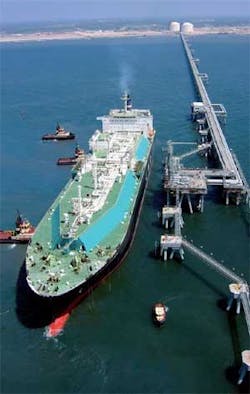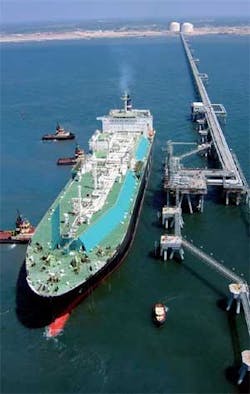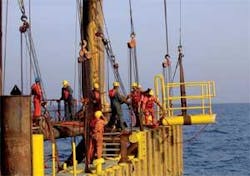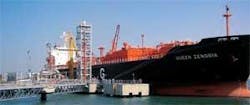With the bulk of its natural gas resource in the Mediterraneansome studies estimate ultimate recovery from deepwater gas reserves at up to 70 tcfand a strategic focus on optimizing the value of its natural gas supply, meeting deepwater challenges will be vital to Egypt’s energy future.
As development continues in the West Delta Deep Marine and Rosetta concessions, new deepwater discoveries also continue to be made. Recent discoveries in the Rosetta concession area, for example, include Mina, Silva, Saurus and Sienna. Development plans for those fields are in progress.
The Mina-1 well indicated a reservoir pressure of about 6,100 psia and a reservoir temperature of 201 °F (94 °C). Silva reservoir pressure is about 4,900 psia and temperature is 162 °F (72 °C). And the Sienna UP-2 well measured reservoir pressure of more than 3,300 psia and a temperature of 129 °F (53 °C).
Scarab/Saffron details
Burullus Gas Co., responsible for developing the West Delta Deep Marine concession, has completed the Scarab/Saffron project, Phase I in the development of the area.
In water depths ranging from 250 m to 850 m (820-2789 ft), the two main structures in the areaScarab and Saffronhold natural gas that contains a very small volume of condensate, and a negligible amount of carbon dioxide (CO2). Reservoir pressure in the zones is about 3,500 psia and reservoir temperature is about 150 °F (66 °C).
In mid 2003, eight wells were capable of producing up to 150 MMcfd of dry gas from the project for Egypt’s domestic market. Those eight subsea wells in the initial development are tied back to two manifolds. The manifolds are connected to shore via two export pipelines that terminate at new onshore facilities adjacent to the Rosetta onshore processing plant in Idku, east of Alexandria.
The export pipelines were initially sized as 20 in. and 22 in., but were subsequently increased to 24 in. and 36 in. to accommodate additional wells.
Wells are controlled from shore using a multiplexed electro-hydraulic control system and umbilical control lines. A 4-in. pipeline from shore to the field delivers monoethylene glycol (MEG) for hydrate inhibition and remediation in the wells and flow lines.
The onshore processing plant was designed for a maximum capacity of up to 600 MMcfd of gas and 3,000 b/d of condensate. But since startup in early 2003, debottlenecking has boosted deliverability to 800 MMcfd.
The plant separates the well stream into gas, condensate and water. Following treatment, the gas is exported via a new pipeline and metered at the tie-in to the Egyptian National Transmission System. Condensate is stabilized and stored on site prior to export through the existing Rosetta condensate pipeline to the Wepco Gas Treatment and LPG facilities at Abu Qir, east of Alexandria.
Produced water is cleaned to recover the MEG for re-use and to extract a salt sludge prior to discharge to the sea. The salt sludge is disposed in a landfill.
Phases II and III
Simian, Sienna and Sapphire fields, in water depths of 900-1,100 m (2,953-3,609 ft), comprise Phases II and III of the WDDM concession development. Simian/Sienna and Sapphire were commissioned in 2005.
The three fields are produced via a subsea tie-back to the existing Scarab/Saffron export pipeline. Offshore elements of the project included the design, installation and commissioning of flow lines, manifolds, pipelines, subsea distribution assembly, umbilicals, a control system and the control platform.
Also during the expansion, the existing Scarab/Saffron terminal was expanded to provide a separate gas feed to the liquefaction plant at Damietta. Modifications included a new slug catcher, high pressure separation, condensate treatment, vent lines, and the pipeline to the LNG plant’s Train 2.
In Sapphire, a field in 400-550 m (1,312- 1,804 ft) of water, eight new development wells will be drilled and completed using multi-zone smart completion technology. The producing zone, the pre-Pliocene Kafer El-Sheikh, consists of five stacked reservoirs of very loose sand with a shale cap rock.
Reservoir pressure is about 4,500 psia and reservoir temperature is 180 °F (82 °C). In mid 2007, eight wells were producing up to 120 MMcfd/well of wet gas containing about 25 bbl of condensate/MMcf.
Two exploration/appraisal wells in both Simian and Sienna were re-entered and completed, and two new development wells drilled and completed in Simian. Reservoir pressure in the two fields is about 3,600 psia and reservoir temperature is 130 °F (54 °C). The producing formation is the Pliocene El- Westani, a channel sand with some interbedded shale and a shale cap rock.
Several advanced technologies and design innovations played a key role in completing the Simian wells, including:
- Wells are completed with an open-hole gravel pack to maximize production, although there is very active shale between the reservoir sands;
- A smart completion technology with down-hole control valves makes it possible to produce the five stacked reservoir sands through the same well bore without the zones interfering with each other;
- All the wells are completed with 7-in. tubing and permanent down-hole gauges to monitor reservoir pressure, temperature and flow rate;
- The wells are designed to avoid the high cost of subsea intervention;
- A regeneration unit saves the high cost of replacing the MEG and is more environmentally friendly.
A small Burullus project management team executed the work in cooperation with other Rashpetco departments. Major contracts included a tendered lump sum deepwater Engineering Procurement Installation and Commissioning (EPIC) contract for the total offshore facilities, and a negotiated lump sum Engineering Procurement and Construction (EPC) contract for the onshore terminal expansion. A lump sum EPC contract was also negotiated for the condensate export pipeline.
WDDM Phase IV
The West Delta Deep Marine Phase IV comprises eight additional wells in the existing Scarab/ Saffron and Simian developments. Five of these wells are in the Scarab/Saffron area, two wells develop the Serpent field and one well develops the Sinbad field. The Scarab/Saffron and Serpent wells tie into the Scarab/Saffron manifolds and the Sinbad well ties into the southern Simian manifold.
This phase is essentially an infill of the existing Scarab/Saffron and Simian deepwater gas and condensate subsea production complex. Existing offshore pipelines move the product from the subsea system to the onshore gas plant at Idku.
Burullus is responsible for all drilling operations, the completion of the offshore wells and the management of the drilling contracts. A key to achieving the fast-track development schedule is to order longdelivery- time items such as subsea trees, connectors and control systems well in advance.
Key drivers for implementing WDDM Phase IV include:
- Meet the aggressive first gas date requirements;
- Fulfill the safety and environmental objectives;
- Provide infill gas capacity to enhance security of supply for the Idku hub;
- Optimize economics, in particular by incorporating the experience of Scarab/ Saffron and the Simian/Sienna and Sapphire developments;
- Leverage opportunities for synergy between Phase IV and the Scarab/Saffron development and the Simian/Sienna and Sapphire development, optimizing the overall controls configuration.
Rosetta details
In Rashpetco’s Rosetta concession, the Phase I area is located about 65 km (40 miles) from the Nile Delta shoreline in the Eastern Mediterranean. One main structure contains relatively dry gas with a very small amount of condensate, no hydrogen sulfide, and little carbon dioxide. The reservoir pressure is about 2,000 psia and reservoir temperature is about 150 °F (66 °C). The initial phase includes six producing wells drilled and completed from an unmanned platform.
Rosetta Phase II includes four development wells on another small unmanned offshore platform producing about 230 MMcfd for the domestic market. The wells were completed with a 7-in. tubing string using “smart well” completion technology. Rosetta Phase III consists of five development wells and all the wells in this phase will be subsea completions tied to the existing Rosetta facilities. Three will be completed using a jack up drilling rig; the other two wells are in significantly deeper water and will be completed using a semisubmersible rig.



